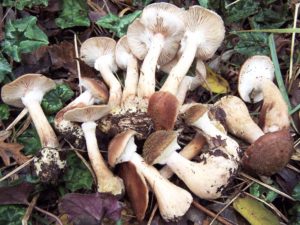
They are colonizers and killers, growing as large as 2,400 acres, leaving devastation in their wake. Armillaria fungi are the cause of root rot disease in forests, fields, parks, and vineyards in more than 500 host plant species across the world. But despite this huge impact on agriculture, the pathogenicity of Armillaria species has been poorly understood.
A new international study led by Hungarian researchers, published in Nature Ecology & Evolution, reveals novel insights into how the fungus spreads and kills. Lead author György Sipos of the University of Sopron, senior author László Nagy of the Hungarian Academy of Sciences, and an international team of collaborators used PacBio long-read sequencing to generate the haploid genomes of four Armillaria species: A. ostoyae, A. cepistipes, A. gallica, and A. solidipes. They also compared them to 22 related saprotrophic, hemibiotrophic, and mycorrhizal fungi.
In the paper, the team reports that Armillaria genomes are “unusually large” for fungi, containing as much as 85 Mb and nearly 26,000 genes, while members of the Physalacriaceae family used for comparison had genomes smaller than 36 Mb with fewer than 14,000 genes. The scientists note that the Armillaria genomes seem to have “drawn upon ancestral genetic toolkits for wood-decay, morphogenesis and complex multicellularity.”
Based on gene mapping and phylogenomic analysis, the authors estimate that the genus diverged from its closest relatives 21 million years ago. While other organisms tended to lose genes in that time, Armillaria species showed a net genome expansion. “The transposable element (TE) content of Armillaria genomes shows a modest expansion relative to other Agaricales and an even distribution along the scaffolds, suggesting that their genome expansion is not driven by transposon proliferation, as observed in other plant pathogens,” the scientists report.
The team also investigated rhizomorphs, root-like materials through which Armillaria spread. “Rhizomorphs are some of the most unique structures of Armillaria spp. that enable them to become the largest terrestrial organism on Earth,” the scientists write. “They express a wide array of genes involved in secondary metabolism, defense, [plant cell wall] degradation and to a lesser extent pathogenesis, which indicate active nutrient uptake and adaptations to a soil-borne lifestyle.”
In healthy forest systems, some fungi are useful for capturing carbon and culling the weakest trees. But Armillaria are not so choosy, and stresses like drought can hasten the destruction of entire forests. The largest expanse of the fungus, as the New York Times points out, occupies an area in Oregon “the size of three Central Parks and may weigh as much as 5,000 African elephants.”
The authors hope their study will contribute to combating future losses. With more genome resources and follow-up studies, they write, this information “could soon bring the development of efficient strategies for containing the spread and damage of Armillaria root-rot disease in various forest stands within reach.”